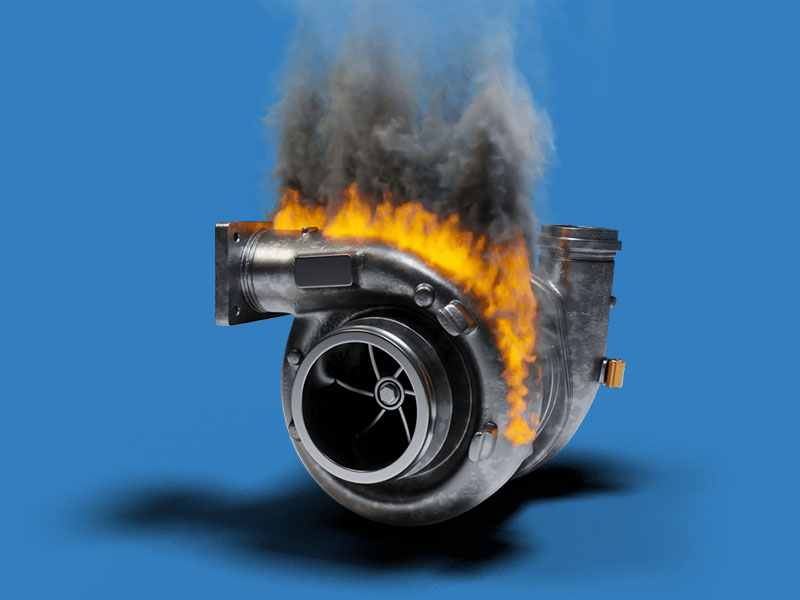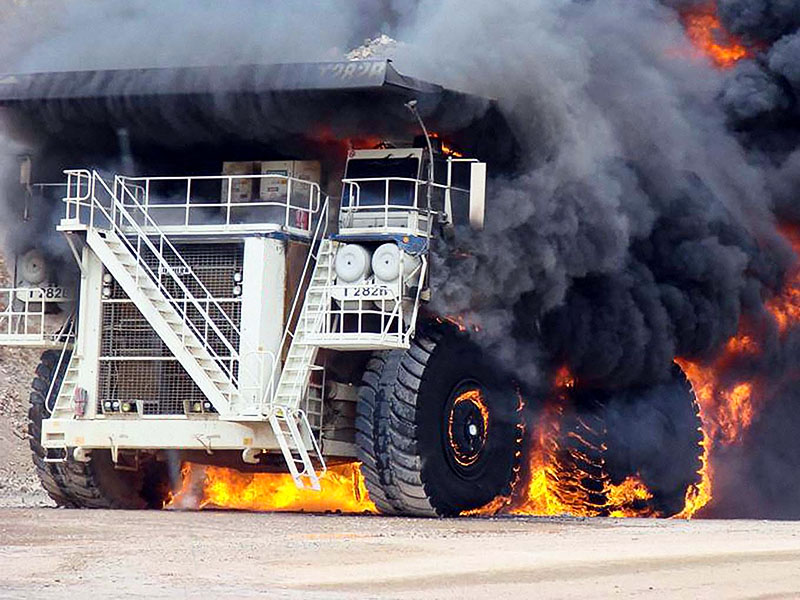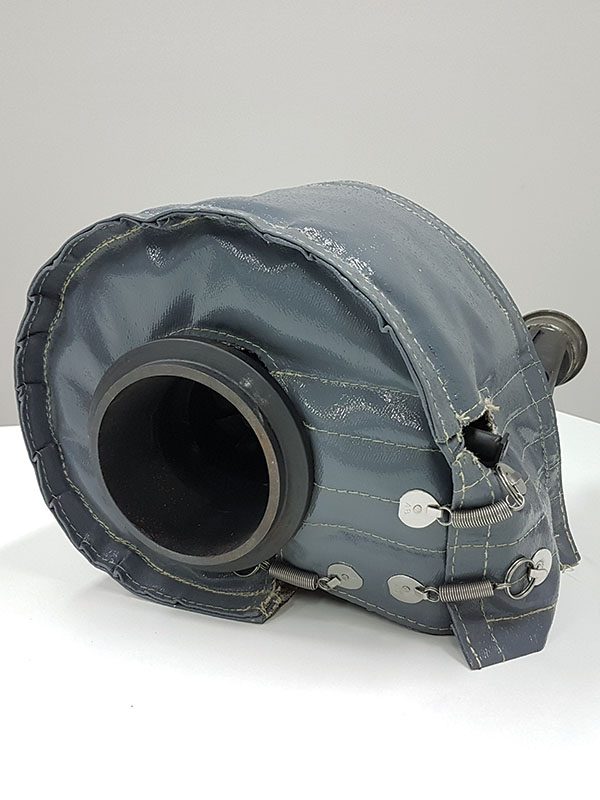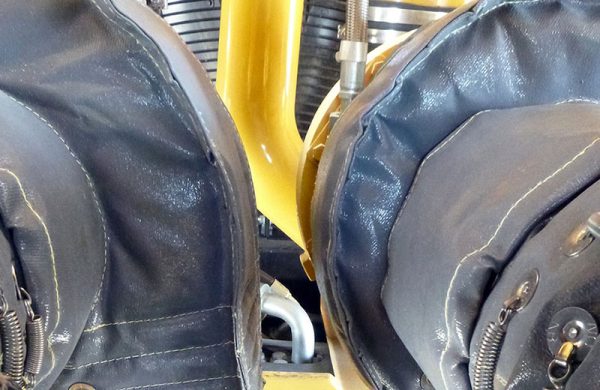
Case Study Overview
In this case study, we’ll reveal insights into common causes of mobile equipment fires and share strategies your crew can use to avoid engine-related fires. A summary of resources and regulations can be found at the end.
PRODUCT GROUP
THERMAL BLANKETS FOR ENGINE SYSTEMS
LOCATION
FIRE MITIGATION FOR MOBILE EQUIPMENT
TARGET AUDIENCE
MAINTENANCE CREWS, RELIABILITY ENGINEERS, PLANNERS
ADVANTAGES
SAFETY COMPLIANCE, FIRE SAFETY, ASSET PROTECTION
AVOIDING COSTLY MOBILE EQUIPMENT FIRES
Fire Prevention for minesite assets
It’s no secret that fire prevention is serious business for mine sites. Mobile equipment fires are costly from both a financial and productivity perspective. Let’s not forget about worker safety, site shutdowns, spikes in insurance premiums, and investigations. A crucial part of our mission at Aletek is to help you prevent engine-related fires and improve your fire mitigation strategy.
Fire reduction strategies from the following bulletin¹ recommend a combination of protection and prevention measures. That’s where thermal blankets enter the equation. High-quality lagging systems provide a physical barrier that shields hot surfaces like exhaust pipes, mufflers, turbos and manifolds.
The burning question – what causes engine fires?
A bulletin¹ by the Queensland Mines Inspectorate provides invaluable insights into open-cut coal mine fires. An analysis of mobile equipment fires in this bulletin helped identify issues.
Mobile equipment fire causes:
- Maintenance activities – 15 to 20% post maintenance activity; this included not replacing oil-soaked blankets and poor installs exposing hot spots
- Blown fuel lines, hose failures and rub throughs
- Turbo failures and cracked turbo oil feed lines
- Lack of engine protection


A WINNING BLANKETS STRATEGY
Blankets help protect mobile equipment
Thermal blankets significantly reduce fire risk by separating fuel and heat sources (see AS 5062:2016 Standard²). For a burst pipe or fuel/coolant leak, blankets may provide a degree of soft protection and impermeability. Additionally, lagging can reduce the outer surface temperature of critical heat components below the flashpoint (maximum 150°C, refer NSW MDG 15³).
Aletek blankets are tailor-made and engineered to provide maximum protection. Our premium blankets consist of an inner stainless steel mesh, silica cloth inner, central silica insulation and a silicone-coated outer. The thick outer silicone layer is high enough to provide a rugged and durable product.
Improving your fire mitigation approach
Aletek strongly recommends that thermal blankets are fitted by experienced personnel. Follow the install order on parts drawings supplied with blanket kits. Correct installation and effective maintenance are critical to effective fire mitigation.
Best maintenance practices include:
- Inspect blankets regularly (monthly inspection recommended)
- Examine blankets for damage and oil/flammable fluid contamination
- Check blankets are fitted correctly and springs/tie-wire secured
- Replace damaged and missing blanket sections
- Refit loose blankets, maximise coverage
- Replace oil-soaked or damaged blankets



REGULATIONS FOR BLANKETS AND FIRE MITIGATION
Below is a collection of resources that relate to minimising mobile mining equipment fires. Why are these regulations and findings relevant? Understanding prevention will contribute towards a well-informed fire mitigation strategy for open-cut mining operations.
¹ Mobile Equipment Fires Bulletin (Qld)
Fixed plant and mobile equipment fires on surface coal mines. Mines safety bulletin no. 158. Source: Queensland Mines Inspectorate
- Common causes of fires reported on dozers and trucks included: Turbo failures, oil soaked lagging, cracked turbo oil feed lines.
- Common causes of fires reported on Drills included: Lack of engine protection.
- Many sites reported turbo fires due to hydraulic hoses or fuel lines failing, then flammable liquids were ignited by a hot turbo or exhaust surface.
- 15 to 20% of fires occurred after a maintenance event. Investigation results included: Oil soaked lagging not replaced, poor fitting of lagging exposing hot spots.
Maintenance strategies include: Consider replacing oil feed and drain lines, seals and lagging associated with the turbocharger when it is replaced. Oil soaked lagging should be replaced and avoid exposed hot spots due to poor lagging fitment.
² AS 5062:2016 Standard
Fire protection risk management for mobile equipment. Source: Standards Australia
- 3.1.10 – Areas where fuel can accumulate should be eliminated. Areas to be considered as a design measure for fire risk reduction include (thermal blankets).
- 3.2.2.1 – Maintenance shall include the necessary measures to maintain controls identified in the fire risk assessment. Inspections to be included during maintenance include: (d) Missing, damaged or poorly fitted lagging or guarding.
- 3.2.2.3 – Areas where combustible or flammable material can accumulate shall be inspected and maintained. They include: (e) Lagging and heat blankets.
³ MDG 15 Guideline (NSW)
Guideline for mobile and transportable plant for use at mines. Source: NSW Resources Regulator
4.4.1 – The surface temperature of the engine system should be controlled to eliminate hot surface ignition of fuels such as escaped hydraulic oil, diesel fuel and engine coolant.
- 2. Commonly, the highest temperature areas are exhaust manifolds, turbo charger exhaust side housings and exhaust pipes and mufflers.
- 3. Surface temperature control methods may include insulating, lagging and water jacketing.
4.4.4 – Effective control measures should be applied to manage these risks (pipe and hose failure), including the following in relation to pipes, lines and hoses:
- c) An effective shielding should be considered between the pipe/hose and any adjacent components which have operating surface temperatures more than 150 degrees Celsius.
Image credits
Water Truck Fire from Australasian Mine Safety Journal
T282 Haul Truck Fire from Engle Martin & Associates blog
YOUR NEXT STEPS
Thermal blankets can help protect your mobile equipment. Our team can share insights on why blankets are essential to your fire mitigation strategy. In addition to practical insights, we have resources such as Blankets User Guides, install cheat sheets and blankets training presentations.
See below or contact us to learn more about our winning range of thermal insulation blankets.
Phone: Call us to speak with a specialist
Email: Contact us to talk more
LET’S TALK MORE
"*" indicates required fields









